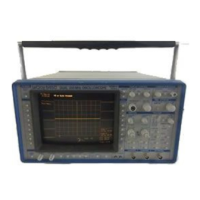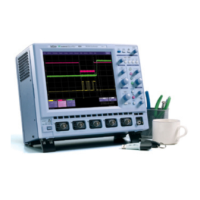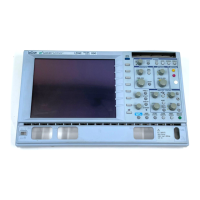RS-232-C Operation
1 GND Protective Ground.
7 SIG GND Signal Ground.
RS-232-C
CONFIGURATION
Echo of Received Characters
by the Oscilloscope
Handshake Control
30
The RS-232-C port is configured in full duplex. This means that
the two sides (i.e. the controller and the oscilloscope) can both
send and receive messages at the same time. However, when the
oscilloscope receives a new command, it stops outputting.
Transmission of long messages to the oscilloscope should be done
while the oscilloscope is in a triggered mode with no acquisition
in progress. This is especially important when sending waveforms
or front-panel setups into the oscilloscope.
The behavior of the RS-232-C port may be set according to the
user’s needs. For this purpose, in addition to the basic setup on
the front-panel menu there are "immediate commands" as well
as a special command "COMM RS232". Immediate commands
consist of the ASCII ESCape character <ESC> (whose decimal
value is 27), followed by another character. Such commands are
interpreted as soon as the second character has been received.
Note: The RS-232-C baud rate, parity, character length and
number of stop bits are among the parameters that are saved or
recalled by the front-panel "SAVE" or "RECALL" button, or by
the remote commands "*SAV’, "*RCL" or "PANEL SETUP".
When recalling, care must be taken to ensure that these parame-
ters are set at the same value as the actual ones. Otherwise, the
host may no longer be able to communicate with the oscilloscope
and a manual reconfiguration would be necessary.
The serial port may echo the received characters. Echo is useful if
the oscilloscope is attached to a terminal. Echoing can be turned
on or off by sending the two character sequence <ESC>] or
<ESC>[ respectively. Echoing is on by default.
Note: The host must not echo characters received from the oscillo-
scope.
When the oscilloscope input buffer becomes almost full, the in-
strument sends a handshake signal to the host telling it to stop
transmitting. When this buffer has enough room to receive more
characters another handshake signal will be sent. The handshake
signals are either the CTRL-S (or <XOFF>) and CTRL-Q
(<XON>) characters or a signal level on the RTS line (pin 4).
is selected by sending the two-character sequence <ESC>) for
XON/XOFF handshake - this is the default - or <ESC>( for RTS
handshake.
|

